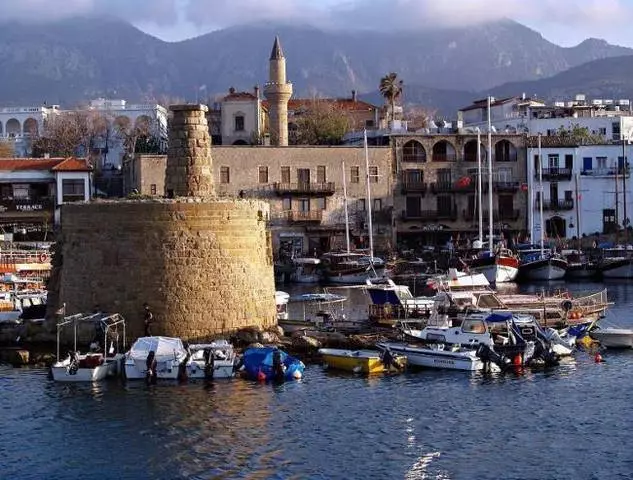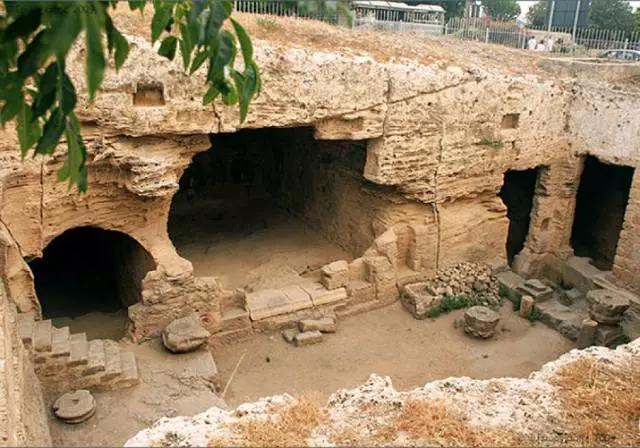Modern pathos can be divided into two parts. The first is the upper pathos, which rises on the hill and is called Kthim. The second is the bottom pathos surrounding the picturesque cove. Tourists, following the road, which leads to the upper pathos, can not not pay attention to the purity and order reigning here. Upper Paphos will certainly meet its guests at any time of the year many colors. Moving along the Mervaas Dienis Boulevard you will pass by the Public Library. Take a photo near it in a massive ionic column installed here in memory of the resistance of the Greeks by the occupying actions of Italians, as well as about the heroic events of 1940. The neoclassical buildings of schools are interesting to tourists, close to tourists (such as, for example, Dimitrion elementary school), entrance to Jacob Stadium, Gymnasium Nicholas and Gymnasium Macaria III. Opposite schools are the urban rule of Paphos and the National Park. Walking in the park, pay attention to the bust of the famous Cypriot Poet of Costis Palamas. And in the depths of a small area of Palamas, it will be interesting to inspect a small fountain with a dome, which is supported by three ionic columns with a copy of the sculpture of sleeping eruta.

From the center of the upper pathos, descend towards the Bay of the Lower Paphos, and during this walk you can visit several archaeological monuments at once and make sure that Paphos is not by chance a unique place. Too many different historical events are reproduced here in dynamics. Going along the street of the Apostle Paul and turning to the right, you will find yourself in the tourist zone of the Lower Paphos, which extends a little northwest port. After walking 15 minutes, you will be suitable for the first interesting attractions on the route - Tsaric Mogylam.
You will find this object by heading north of the ancient pathos. "Tsarist graves" is a cemetery with numerous underground graves that are cut right in the rock. They date back to the 3 century BC, the times of the Ptolemyev era. This is, in fact, ordinary burials, which are not actually the tag graves, and they received their name through their unique architecture. In some burials, you will see the crosses and frescoes that the story will tell you that many people subjected to Christians subjected to many centuries ago. The most interesting are those from the graves that are surrounded by open courtyards with doric columns. You can get here, descending down the stairs, which is cut right in the rock. Bygoing this historical monument, come back on the same road and close to the intersection with the street of the Apostle Paul, connecting the upper and lower pathos, to the left you will see the catacombs of Saint Solomon.

Catacombs Saint Solomons are also cut down in a rock. During the Hellenistic Epoch and in the continuation of the I century BC. They were used as refuge, but later turned into a Christian church dedicated to St. Solomon and her sons. According to legend, Solomon, pursued by Roman soldiers, found his refuge in this cave and was inspired there. Not very well-preserved wall drawings on the right side of the cave are dating 9-12 centuries. AD Your attention will certainly attract handkerchiefs and pieces of fabrics, woven on a tree, which is located at the entrance to the cave. According to legend, if a person suffering from a chronic disease will leave the treason on this tree from his clothes, he will get rid of the illness.
Not far from the port of Paphos are beautiful mosaics. The buildings of the Roman era are worthy of attention. These include the Music School of Paphos, Agora and Asclepion. Visit the residents of Dionysus, Tezay, Orpheus and Eon.
In the mid-20th century, the archaeological excavations conducted by many countries led to the fact that the Roman Palace was known to the general public, in which today you can explore the most famous mosaics of Cyprus. Due to the fact that in the mosaic scenes adorning the palace, the plots of the image of the god of Dionysus prevail, this building was called Dionysus Residence. Its area is more than 2000 square meters. m. Of these more than 500 sq.m. Covered amazing beauty mosaic. The main topics of mosaic paintings are connected with Greek mythology. Constantly meeting scenes of hunting and image of animals. In total, in the halls of this dwelling more than 40 rooms. In the center of it is the courtyard, surrounded by numerous columns. Moreover, it is here not far from the court, one meter was deeper than all the others were found the most ancient mosaic picture. It consists of a variety of small marine stones of white and black and dates back to 3 centuries BC. The building was completely destroyed by an earthquake in 4 c. AD And never has been restored since then. An interesting fact is associated with the roof that covers this archaeological reserve. In 1964, an ancient amphora was discovered in this place in this place, an ancient amphora was discovered in this place, in which the preserved silver coins of the Ptolemaev era were found. According to the existing classification, this is the biggest treasure found ever in the territory of the island state.

In the middle of the last century, the Polish archaeological expedition of Iia, who worked in Cyprus, discovered another Roman building in this area, which is now known as the dwelling of Tezay. Such a name was assigned to him because of a mosaic, which depicts the Battle of Tezay with the Minotaurus. The palace rched himself very close to the port of Paphos, a few dozen meters south from the donisis housing. This construction, built, presumably in the 2nd century AD. It covers an area of about 10 thousand square meters. The building consists of numerous rooms, and outside is surrounded by several columns. Paul here is decorated with mosaic paintings.
Next to the housing is another interesting to visit the object - Eon's home. This historic structure was built in honor of God Eon. It is depicted here on the central mosaic picture. During the excavations of historians, they found magnificent mosaics illustrating legends and myths of ancient Greece. The dwelling of the Orpheus is west of the dwelling of the toze and dates back to 3 century AD. Here, archaeologists during excavations found several mosaic paintings, including: "Amazons", "Hercules and Nemoye Lion", "Orpheus and Monsters".
